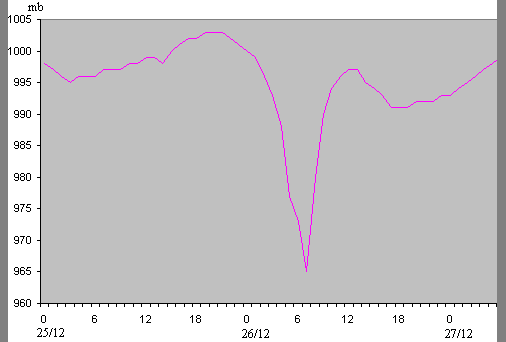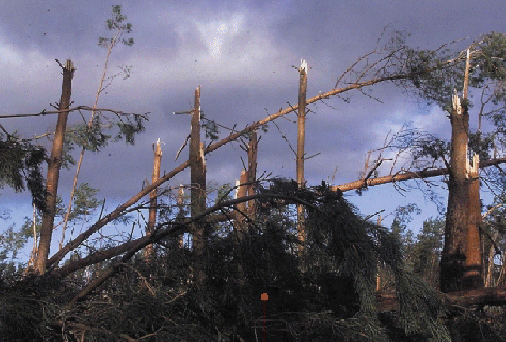Weather
Lothar and Lothar successor
|
Image of the barograph from Paris Charles de Gaulle airport 25 - 27 December 1999
|
|
Lothar was characterised by its small scale, its rapid development and its high wind speeds.
The drop in surface pressure was dramatic (see diagram above), falls of more than 10 hPa/hour were measured over NW France and the rise in pressure immediately following the passage of the low
was approximately the same.
The storm track followed a semicircle and was about 200 km wide. It started over the English channel and moved over the Paris area towards Alsace, the German Black Forest and northern
Switzerland, losing its strength over Austria and the Czech Republic.
Within this 200-km wide track over France, Germany and the northern part of Switzerland, 10-min. averages of max wind greater than 50 kt (10 Bft) were measured. Wind gusts varied between 80 and
100 kt with a maximum of 117 kt at Pontorson (South Normandy).
In the storm frontal zone, moderate rain was reported. Further to the east, heavy snowstorms and blizzards over higher grounds were reported.
After 25 December 06.00 UTC, a squall line developed south of Paris, and moved towards Switzerland, with heavy showers, hail and thunder.
Martin
Storm Martin was much larger than Lothar and the area in which the 10-min average max. wind exceeded 50 kt was approximately 500 km wide over the southern and western parts of the storm.
Highest winds were reported over the coastal areas of southern Brittany, and the Bordeaux area, towards northern Spain, between 12.00 and 21.00 UTC. The fall and rise in surface pressure before
and after passage of the centre were, as with Lothar, also close to a 10 hPa/hour. Windgusts in the above mentioned area were mostly between 70 and 90 kt with a maximum of 107 kt over the
Island of Oleron.
During passage of the frontal systems, moderate to heavy rain was reported with heavy snow on higher ground. In the colder airmass behind the Cold Front, showers occurred, some with thunder.
Economic Damage
The death toll of Lothar and Martin was over 150 victims of which nearly 90 were in France.
Structural damage was wide-spread over Europe and was reported from France (most damage), Great Britain, Germany, Belgium, Luxembourg, Spain, Switzerland, Austria, Italy, the Czech Republic and
Poland.
Transport in some of these countries was disrupted for several days.
In France 2.5 million households were without electricity and after a week, half a million households still had no electricity. 4% of the forests were destroyed, representing more than 90
million cubic meters of timber.
Structural property damage was enormous: In France one out of twelve schools were damaged and the damage caused to historic monuments exceeded 120 million Euros.
The total cost of damage caused by the two storms is difficult to calculate but it will certainly exceed 6 billion Euros.
|
The remains of a forest on the Isle of Oleron (France) after Martin
|
|

